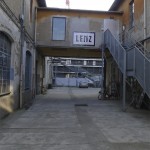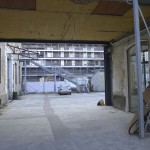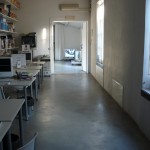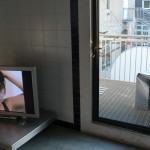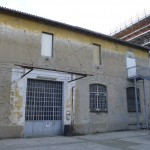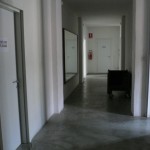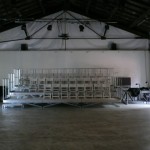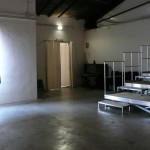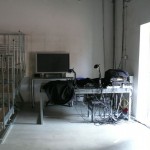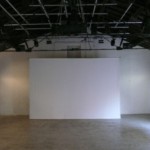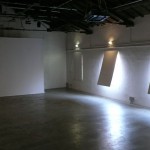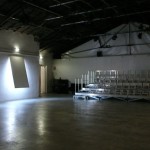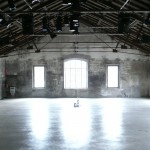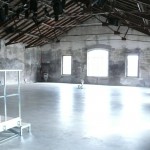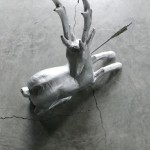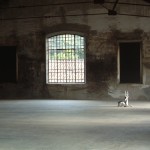
LENZ THEATRE
Since 1988 Lenz Rifrazioni has been working in an industrial building on the historic outskirts of Parma, in an area close to the city centre, but still marked by the industrial origins of the district, where the large glassworks established at the end of the nineteenth century are still active.
The presence of Lenz Teatro in the S. Leonardo district represents the displacement of the place of artistic production from the centre to the periphery, the distancing from the traditional concentrations of culture, the identification of the axis out of the city (A1 motorway and railway) as a possibility of communication with the extra-urban territory. The recovery of this space constitutes the possibility of redeveloping and refunctionalizing an urban area of extraordinary historical and symbolic importance for the city.
Following a serious fire that made the space unfit for use for about two years, Lenz Teatro was reopened to the public in September 2001, after a major renovation by the architect Isabella Tagliavini, which led to the adaptation of technological systems, the re-functionalization of service areas and the removal of architectural barriers.
Lenz Teatro has preserved the industrial identity of the production spaces, highlighting their architectural and functional characteristics. The surface of the premises is about 1000 square metres. It is equipped with two theatrical halls, an entrance hall, an office area, an archive room, two dressing rooms, a stagecraft workshop, a costume shop, a make-up room, four toilets (including a service for the disabled), a warehouse, a lift, three staircases and emergency exits. Lenz Teatro is a place of cultural production, theatre experimentation and training, and musical research.
MEMORY OF WORK. THEATRE SITE
1988 revealed to us the secret spaces of the building, the great halls, the rooms, the corridors, the windows on the courtyards, the attic. Pathways, voids, from the exterior into an interior, a labyrinth of streets in an urban body sandwiched between other bodies similar in function and architecture. Its birth dates back to the 1930s. When we walked through it for the first time we were already inside a possible scene, the acoustics of the rooms were immediately generous and the subdivision of the spaces, functional to the work of the workers, was perfectly suited to the work of the theatre. A workshop and research theatre. A working theatre, therefore.
We removed only a few walls that had been added over the decades, installed an air heating system and an electrical system suitable for theatrical use. We have created an entrance hall with a staircase that complies with standards, a reading room, two large performance rooms, a hospitality room, two offices, a stage workshop, make-up rooms and two bathrooms. Bruno Ganz and Edith Clever thanked us for taking them back to the days of the first Schaubühne and giving them back a “way and an air” that they thought had been lost.
All the spaces in the building are used for performances according to the different dramaturgical choices, but it is in the two large halls that we realise most of the artistic works. Majakovsky Hall and East Hall. Poetry and the East, two central points in the work of Lenz Rifrazioni. Poetry as necessity and the Orient in tragedy. Hölderlin. The empty space, horizontal and vertical, down and up, is filled with actors’ bodies, voices, sounds, artificial and natural colours according to dramaturgical lines and curves. And everything remains, beyond the performance, impressed in space. In the memory. But also on the walls, on the floor, on the iron rods, on the roof of beams and bricks. The work continues to leave recognisable and unrecognisable signs, in the light or hidden, for everyone or for someone.
The whole building is located in a historic district of the city, historic for industrialisation and urban quality; from a district of workers’ struggles and dormitory, it is fast becoming an extension of the commercial and tertiary centre. Architecture is changing rapidly and demolishing the great industrial centres of the past, leaving a few spaces that the city should recover for cultural and productive functions. Art always needs space. As does man, for that matter.
Francesco Pititto, 1992
THE SPACE OF THE THEATRE
“The theatre space, to be alive, must have proportions and memory. If it is no longer the spectators’ palace or the museum of culture, it can be the actors’ home. A place inhabited even before and after the performance, a place of work in which one is interested in being a guest. One can certainly live in houses built for others or for something else (this is what is usually done); one can also build a house in which to live as artists and in which to receive guests. Here the spectator who comes to the performance feels the lived space and sees that space as a living and functional element of the performance itself; here the space of the performance creates the condition of its being watched, it creates the spectator.
In Greek culture, the theatre was one of the sacred places of the polis; in Renaissance theatre, the myth of ancient space was reversed, however, in the practices of the court hall, the place of self-celebration; the civilisation of the bourgeoisie made the theatre the monument of the city, first as the Church and the Town Hall, then as the Stock Exchange and the School or the Museum; today the theatre is the separate space in which those values of interrelation, painfully and dramatically reconquered from daily negation, are exalted. But every theatre project will remain only a monument or will become like those uninhabited houses of which only the façade remains if it is not given as a home to theatre people”.
This is how Fabrizio Cruciani, one of the most sensitive Italian theatre scholars, ended chapter eight – Lettera a un architetto – of his research “Lo spazio del teatro” (The theatre space) and this fragment continues to tell the story of our experience perfectly. Lenz Teatro represents one of the very few examples of concrete theatre in Italy obtained from post-industrial spaces reinvented as an artistic home by the stubborn and private will of a group of artists, Lenz Rifrazioni. Since 1989 until today hundreds of student actors, thousands of spectators, dozens of artists and companies from all over Europe have been our guests in Cruciani’s sense.
Today this place is undergoing a radical transformation as part of a broader “urban requalification” and a project for a new theatre on the structure of the old one has been carried out by one of the most advanced architectural firms in the world – Oriol Bohigas’ MBM Arquitectes – but we still do not know whether it will be built or whether a new building will be constructed, for now classified as a “cultural centre”. We have been listened to and we have indicated many priorities in order to maintain continuity with the experience we have practiced up to now, never separated from an artistic ethic and aesthetic, but while we wait for a decision beyond our control, we would like to take stock of the contemporary state of affairs regarding the theatre space, starting from the research mentioned above.
In recent years, several Italian cities have recovered industrial archaeology spaces for cultural use, as has been done for decades in England, Germany and France, but the increase in “housing” possibilities has not always favoured the birth of new expressiveness and permanent linguistic dynamism, but rather the quantitative response to a need for a home for many realities in search of spaces, but which in most cases are reduced to necessarily temporary solutions given the chronic lack of adequate public support to ensure continuity. Moreover, without any reflection on the relationship between dramaturgy and designed space, between actor and spectator, between perception and creation. The historical and monumental spaces used for temporary installations and theatrical, musical or dance performances undergo a temporary metamorphosis, enhancing both their status as buildings representing the history of a community and their intrinsic willingness to become prestigious contemporary containers. The Reggia di Colorno is a superlative example of this aesthetic, architectural and artistic ductility. On these and other topics, the thirteenth edition of the international festival Natura Dèi Teatri opened a free and informal debate between architects, creative people and artists, between technicians and spectators present during the performances and events.
Francesco Pititto, 2008
Spazi Lenz
Sala Est
Sala Majakovskij







![[cml_media_alt id='2313']totale[/cml_media_alt]](https://lenzfondazione.it/wp-content/uploads/2014/04/totale.jpg)
![[cml_media_alt id='2315']maja[/cml_media_alt]](https://lenzfondazione.it/wp-content/uploads/2014/04/maja.jpg)
![[cml_media_alt id='2316']est[/cml_media_alt]](https://lenzfondazione.it/wp-content/uploads/2014/04/est.jpg)


